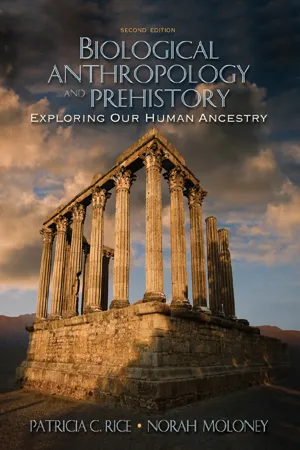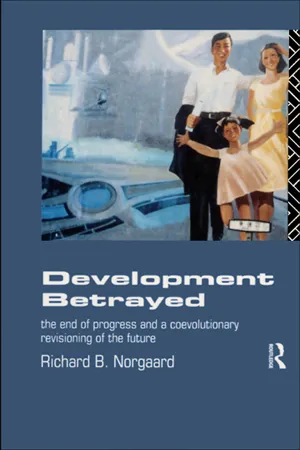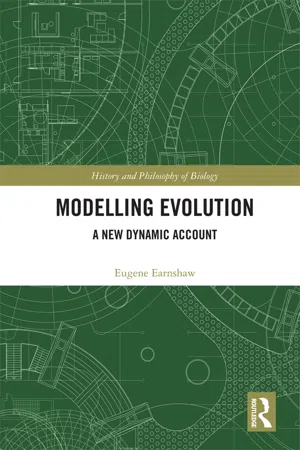Biological Sciences
Evolution process
The evolution process refers to the gradual change in the genetic makeup of a population over successive generations. It is driven by mechanisms such as natural selection, genetic drift, mutation, and gene flow, leading to the adaptation of organisms to their environments and the emergence of new species. This process is fundamental to understanding the diversity of life on Earth.
Written by Perlego with AI-assistance
Related key terms
5 Key excerpts on "Evolution process"
- eBook - ePub
Biological Anthropology and Prehistory
Exploring Our Human Ancestry
- Patricia C. Rice, Norah Moloney(Authors)
- 2016(Publication Date)
- Routledge(Publisher)
evolution is still “biological change through time.” Fleshed out a bit, biological evolution is the process by which ancestral populations accumulate morphological and genetic changes to become more modern populations. Given this definition, biological evolution is fact, not hypothesis or theory, because change can often be observed.For example, controlled experiments with fruit flies show the fact of evolution. If a fruit fly population is left alone in a cage with banana mush but no human manipulation, experimenters can compare two generations of fruit flies morphologically (in terms of outer appearance), inferring their genetics, for signs of change. Geneticists traditionally use fruit flies because some of their chromosomes are large and easily observed, and generation length is a mere two weeks. Variations in such observable traits as wing size (long, medium, short, or just nubbins) or eye color (red or white) can be counted for the first generation and recounted when the second generation takes its place, and simple proportions compared. The proportions will probably not be exactly the same. If the populations are numerically large, mutations or selection may alter the counts slightly; a single mutation, for example, can change wing size to nubbins in the mutated individual. If the populations are numerically small, chance will probably alter the counts. In any case, when a new population has changed biologically through time, it has, by definition, evolved. This change can be observed and measured. After five or six generations of fruit fly evolution, again with no human manipulation beyond feeding and removing dead flies, patterns of evolution can be established and causes hypothesized for the accumulated change. We will explore evolutionary causes later in this chapter.Other lines of support, too, point to evolution as fact. First, the fossil record shows many different kinds of support for evolution. Scientists trace entire lineages by documenting succeedingly older and older fossils, demonstrating that change is occurring over time. Second, many cases of natural selection can be documented in nature. Such cases show how differential success in reproduction in a population results in differences in morphology and genetics in subsequent generations. Third, on the molecular level, humans are said to share 98.7 percent of both their structural genes and DNA with chimpanzees and bonobos. This argues strongly for a common ancestor of those three modern species in the not-too-distant past (Marks 2000a, 2000b). On the other hand, both humans and apes share a lot of their DNA with bananas as well (Marks 2000a)! The fact that all life - eBook - ePub
Development Betrayed
The End of Progress and a Co-Evolutionary Revisioning of the Future
- Richard B Norgaard(Author)
- 2006(Publication Date)
- Routledge(Publisher)
average they were slow. And since no one had seen evolution in their lifetime, the process must have been slow. The directionality of evolution was clear since the physical niche is given. The gradualist explanation has been so effective in conveying the idea of evolution in the classroom and to the public generally that it has overridden our deeper understandings of the process. This common, simple explanation rules to such an extent that biologists themselves sometimes have to be reminded that our understanding of evolution was always more complex and has also evolved dramatically over the past three decades.When species evolve in response to changes in each other rather than a predetermined physical niche, all evolutionary direction is lost. Furthermore, when the selective forces themselves change, evolution and extinction are likely to occur at very uneven rates. Thus the dominant view among evolutionary theorists now is that groups of interacting species, at different times and places, have periods during which they share many characteristics which fit together. During these periods when traits have evolved such that they can be thought of as, metaphorically speaking, locked together, evolutionary change is slow. Locked together, the characteristics of each species in the group reflects the characteristics of the other species in the group. When locked, evolutionary change continues slowly. Periods of rapid evolution among a group of species, and changes in the composition of the group, can be initiated by the introduction of a genetic trait or species from another area or by a mutation in one species which proves fit. As the group becomes “unlocked”, criteria for fitness change significantly, and with new selection criteria, evolution can occur more rapidly. Whatever the source, the new fit characteristic of species, or the loss of characteristics or whole species, puts new selective pressures on the other species. When these new selective pressures are sufficient that they unlock the interactive fitness of the group, evolutionary change can be fast. Thus evolution is now thought of as occurring at widely varying rates, and sometimes quite quickly. - eBook - ePub
- David Baum, Douglas Futuyma, Hopi Hoekstra, Richard Lenski, Allen Moore, Cahterine Peichel, Dolph Schluter, Michael Whitlock(Authors)
- 2013(Publication Date)
- Princeton University Press(Publisher)
IV Evolutionary Processes Michael C. Whitlock As the great population geneticist (and statistician) Sir Ronald Fisher said in the first sentence of his foundational Genetical Theory of Evolution, “Natural selection is not evolution.” A population evolves when the frequencies of its genotypes change over time. The most important of these changes are typically caused by natural selection, but selection is not the only mechanism by which evolution occurs. When alleles are passed from one generation to the next, the next generation may by chance not exactly match the generation of its parents, especially if the population size is small. Alleles can mutate to new alleles, and alleles can arrive by migration from genetically diverged populations. DNA sequences may recombine with genetically distinct sequences. The details of mating can matter, because genotype frequencies can change as a result of mating between relatives, mating between similar individuals, or mating with nearby individuals. All these factors—random genetic drift, mutation, migration, recombination, and nonrandom mating—can change the genotype frequencies in a population from one generation to the next; in other words, they can cause evolution. This section discusses these nonselective evolutionary processes and some of their important consequences. We start with a discussion of random genetic drift (see chapter IV.1). In a finite population, chance in part dictates which individuals happen to succeed and leave offspring; therefore, chance can cause the allele frequency to change from one generation to the next. This random process, called genetic drift, changes the allele frequency from one generation to the next. Such drift has greatest effect for alleles that have very small effects on fitness - eBook - ePub
Modelling Evolution
A New Dynamic Account
- Eugene Earnshaw-Whyte(Author)
- 2018(Publication Date)
- Routledge(Publisher)
5 Evolution in the social sciencesChallenges
The specter of biologism
The view that the concepts of evolution by natural selection should in principle be applicable to broader domains than biology has been very widely held, beginning with Darwin. But enthusiasm for particular attempts to put this into practice has been rather less comprehensive. There is no major domain outside biology where an evolutionary paradigm is widely accepted, let alone forms the basis for the discipline. Evolutionists at best form well-known but marginal subgroups in the social sciences, whether it is in economics, anthropology, psychology, or the history of technology.In the evolutionary social sciences there is no set of agreed upon concepts, models, or methods. Different authors take different aspects of evolutionary theory to be central. Mokyr (1992, 2002) focuses on the distinction between phenotype and genotype. Basalla (1988) takes gradualism to be fundamental. Campbell (1960) emphasizes the role of blind variation. For Dawkins (1976) and Blackmore (2000) the notion of replication is indispensable. Hull et al. supplement replication with repeated cycles of variation (2001). Aldrich et al. drop replication for conservation of information under resource scarcity (2008). Nelson and Winter (1982) construct their models around mechanisms analogous to selection and mutation. Richerson and Boyd (2005) emphasize processes distinct from those found in biology, supplementing natural selection with various forms of biased transmission specific to human culture. Andersen (2004) gives the Price equation a central role in a view otherwise similar to Hull et al.The attempt to decipher which of these approaches are sensible and which are confused is rendered problematic due to the tendency of most philosophical accounts of evolution to narrowly address biological situations. While this narrowness is perfectly understandable given the historical origins and pragmatic use of evolutionary theories, it has led to problems. I refer to this characteristic limitation of evolutionary accounts as ‘biologism’, a bias that colours the vast majority of writings on the topic. Its consequence is distorted understandings of evolution that are tied to a narrowly biological conception of evolutionary processes. - eBook - ePub
Human Biodiversity
Genes, Race, and History
- Jonathan Marks(Author)
- 2017(Publication Date)
- Routledge(Publisher)
2Processes and Patterns in the Evolutionary History of Our Species
The processes of evolution operate on gene pools, and accrue to species. The processes of evolution are consequently genetic processes, but the patterns they produce are taxonomic. Relating them to each other in practice involves the creative use of narrative.Narrative as a Scientific Medium
All human intellectual endeavors use language: it is one of the primary autapomorphies of our species. Science is such an endeavor, and science is constructed fundamentally of language. Finding out about the universe is the main goal of science, but our comprehension of it is constrained by our own mental linguistic processes; and learning about the universe is useful only to the extent that insights can be communicated to others, which further constrains the scientific process through language. Sometimes the linguistic structure of science is obvious, as in the metaphor that attributes “charm” to subatomic particles. It can also be more subtle, as in the inference that the scientific endeavor proceeds by a sequence of (1) background information, (2) materials and methods, (3) results, (4) discussion, and (5) conclusions—simply because scientific papers are written that way.1Though all science has special linguistic features of narrative, the science of human origins has a particularly self-conscious streak. Consequently, the structure that linguistic forms have imposed upon biological anthropology—the way in which the medium becomes mixed with the message—has been more intensively examined here than in other sciences.
Learn about this page
Index pages curate the most relevant extracts from our library of academic textbooks. They’ve been created using an in-house natural language model (NLM), each adding context and meaning to key research topics.




